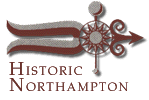
Archives & Manuscripts Costumes & Textiles Daguerreotypes & Photographs Decorative Arts Fine Art Other Collections Furniture Digital Collections 
|


The Howes Brothers Photographers
 |
39 Water Street, Leeds, The Howes Brothers Reproduced from the original glass plate negative by Stan Sherer |
The Howes Brothers of Ashfield, Massachusetts - Alvah, George and Walter - were itinerant commercial photographers who traveled western Massachusetts and beyond taking and selling photographs during an era when few people owned cameras of their own. The most common type of photograph is a family or individual lined up in front of their residence. The Howes Brothers also photographed people at school and at work: children grouped in front of their schoolhouse, a blacksmith outside his blacksmith shop, loggers wielding axes among felled trees or a delivery man in his wagon. From approximately 1886-1902, the Howes Brothers took thousands of photographs on dry-plate negatives traveling the Pioneer Valley, the hilltowns of western Massachusetts, south to Connecticut as far as New Haven, north into southern Vermont and even eastward into parts of central and eastern Massachusetts. The people photographed are in most cases unidentified. Unlike a studio portrait, they are linked to their property, photographed in the world they inhabited.
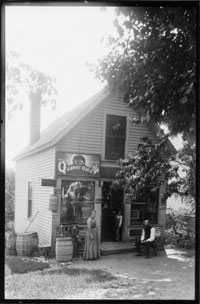 |
245 Bridge Street Northampton, MA |
Gerald McFarland and Alan B. Newman describe the world of the Howes Brothers in the book, New England Reflections 1882-1907: Photographs by the Howes Brothers. Alvah Howes, born in 1853, worked in the photography business from 1886 until 1907. The eldest of five brothers born to George Howes in Ashfield, he employed his younger brothers, Walter (born 1861) and George (born 1865), after his entry into the photography business. According to Dr. McFarland, Alvah may have been introduced to the photography business while working as a farm laborer for an Ashfield neighbor, Henry Ranney: “Fragmentary evidence suggests he entered the profession in the mid-1880s, perhaps through a connection with a man named Elliott W. Cook, who lived in the Ranney homestead where Alvah boarded. In the 1880 census, Cook listed his occupation as ‘traveling agent,’ but later in the decade he practiced photography, giving an Albany, New York address on his prints. Whether Alvah received his early training from Cook or worked with him is not known, but there was clearly some link between the two men’s careers since several photographs taken in the mid-1880s have Cook backings with Cook’s name crossed out and A.W. Howes printed in its place.”
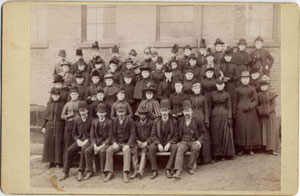 |
The Kingsbury Box Company North Street, Northampton, MA |
In the late 1870s, the innovation of the glass dry-plate negative allowed entry into the photography business for an investment of no more than $100. The equipment needed to take, develop and deliver the finished prints could be transported by wagon out beyond the studio. Alvah and his brother Walter began traveling in the “view business” in 1886. Walter Howes kept a notebook from 1886 to 1900 titled “Places We Have Boarded at in View Business.” Due to family connections, the brothers first went to Florence, where they boarded with “O. Lillys.” That same year, they boarded in Orange, Massachusetts and then returned to Northampton, boarding with John Welch. In spring 1887, they traveled to Connecticut, boarding first in South Coventry with their brother William, who worked there at a box factory. By 1888, Alvah opened a portrait studio in Turners Falls. From 1888 to 1894, Walter and a neighbor from Ashfield, Harry Sturtevant, traveled on the roads, taking turns as the photographer, while a third person, either George Howes or “a Ranney boy” from Ashfield, drove the photographers’ wagon and ran errands. Alvah remained in Ashfield, developing finished prints from his studio. By 1894, Alvah closed his studio due to a decline in business after the economic depression of 1893 and returned to touring on the road, this time as A.W. and G.E. Howes Photographers.
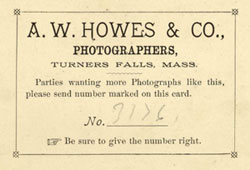 |
Imprint for A. W. Howes & Co. |
Gerald McFarland describes their method of operation, based in part on letters written by Walter to his fiance in 1888. Touring took place during the months of April – November; the brothers returned to Ashfield for the winter months. After securing a place to board, they would seek commissions, visiting schools and factories to line up orders and going door-to-door to invite people to have their pictures taken. Prints were offered three for a dollar. The Howes Brothers used a 5 x 7 inch view camera mounted on a tripod. Inscribed near the edge of each negative was an identification number and occasionally a year. The finished print was printed on the photographic paper, Artistotype, and mounted on a stiff card, measuring approximately 6 ½ x 4 ¼ inches. On the backside of the card was the photographer’s logo with a negative number for reorders: “A. W. Howes & Co., Photographers, Turners Falls, Mass. Parties wanting more Photographs like this, please send number marked on this card. Be sure to give the number right.”
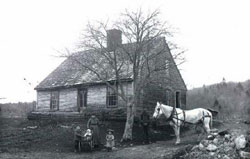 |
Sylvester Road, West Farms |
Walter K. Howes’ notebook lists two additional photography tours in Northampton and Florence. In addition to boarding in Florence and Northampton in 1886, the Howes brothers boarded in Northampton in 1890 with Wm. H. Howes and in Florence in 1900. The 1900 census lists the brothers during their stay in Florence. Alvah and his wife, Eliza, rented a house at 19 North Maple Street. A 21-year-old employee, Ethel Rice, boarded with them, her occupation listed as "Printer Photographs." Walter and George rented a house on Chestnut Street (listed as 78 Chestnut Street in the census and as 72 Chestnut Street in the Howes' notebook). Enumerated on the census are Walter and his wife, Ida; Walter and Ida’s three children and George and his wife, Hattie. Both Walter and George met their wives while touring. Also listed are two additional photographers, Leon D. Drake and Harlow W. Phillips along with his wife, Amy L. Phillips.
In 1903, Walter and George purchased a cousin’s interest in a Florence trucking firm and eventually operated the Howes Brick Company in Northampton and Florence. Alvah returned to Ashfield in 1903, working there as commercial photographer until 1907. He ran a small dairy farm in Ashfield, worked as the town’s lamplighter and helped maintain Ashfield’s cemeteries. Alvah Howes died on November 25, 1919. George Howes passed away on January 13, 1925. Walter Howes outlived both brothers, passing away on January 6, 1945.
 |
Developing Wet Plates |
Despite two decades of photographic work, no formal effort to preserve the photographic prints or negatives was undertaken when the brothers changed careers in the first years of the 20th century. In the early 1960s, the Zachariah Field Tavern, the last studio-residence of Alvah Howes, was put up for sale. Stored in the attic were wooden crates containing glass negatives. The owners soon donated them to the Ashfield Historical Society. Another Ashfield resident donated a set of glass negatives that had come into their possession. The daughter of Howes assistant Ethel Bates donated numerous photographic prints. To preserve and interpret the Howes Brothers work, the Ashfield Historical Society undertook the Howes Brothers Photographic Preservation Project. The project resulted in climate-controlled, fire-proof storage of the negatives and prints, a full catalog of their work, exhibitions and the publication of the book, New England Reflections 1882-1907: Photographs by the Howes Brothers. Curator Norma Harris and researcher Theodore Hendrick spent decades researching and cataloguing the prints, identifying the sites by street address. Microfilm copies of the images were made available to libraries at the University of Massachusetts at Amherst and Greenfield Community College. In the 1970s, the Ashfield Historical Society donated to Historic Northampton 738 glass-plate negatives taken by the Howes Brothers of Northampton, Florence and Leeds. The photographs are identified by street address. View the collection online on the Online Research section of the museum’s website.
References:
Matthews, Richard, "Through the Eyes of the Howes Brothers," Hampshire Life, Daily Hampshire Gazette, July 24, 1992.
Newman, Alan B., New England Reflections, 1882-1907: Photographs by the Howes Brothers, New York: Pantheon Books, circa 1981.
Contents Historic Northampton.